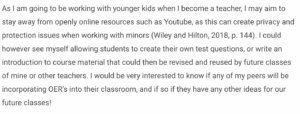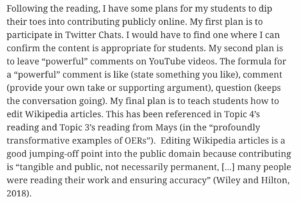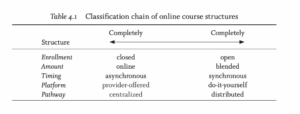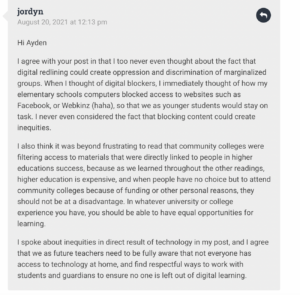1. Describe the potential of human-centered learning in distributed and open learning contexts
Human-centered learning is really all about focusing on the individual rather than the content that is being produced within education. So much of what is produced in both young learning curriculums as well as in higher education, especially by the student, lacks the ability to use the 5 r’s that Wiley and Hilton (2018) discussed within their article surrounding OER-enabled Pedagogy through student-centred approaches to learning (p. 134). Distributed and open learning environments are perfectly imperfect systems that students can use to produce work that can be “retain[ed], reuse[d], revise[d], remix[ed], and redistribute[d]” (p. 134). One of my pod members, Samuel, created his week 4 post structured around OER-enabled pedagogy that captured the concept of closed education systems in which “[a]ccording to Wiley, D. & Hilton, J. (2018), “millions of hours of work are done, graded, and thrown away each year””. I responded to his post outlining a potential suggestion I had for professors to allow more of the 5 R’s into their closed learning environments. I stated:
“I wholeheartedly agree that so many of our assignments are structured around closed systems, and unfortunately this means that many of our assignments are completed, graded, and then thrown away. Throughout my high school career, I had a few of my teachers reach out to me or my friends and ask if they could use my assignments for future classes, such as the Spanish Youtube video that we created and that I explained within my post, but within University I have never heard of any professor asking to keep work stored for future use. Do you or any of my pod members know if this has to do with a potential privacy or protection issue, or if this is just not something professors do? Perhaps they do it and my work just has not been sufficient to keep (haha). I would be very interested to know if you or any of my pod members have had a professor ask to keep any of your assignments! While reading your post, I thought about how cool it would be if students in higher education could have the option to share their projects/assignments to a secure folder once it has been completed and graded that could then be used for future professors to show other students taking their courses… perhaps there could be a criteria that states a student has to have a certain percentage on the assignment in order to submit? Although this is still considered closed because the file is secure and not open to the public, it could benefit other students in the future and allows work to be reused. I’m not sure why more professors don’t utilize other students work as examples, as I know personally having examples of past students works, such as the ones we had for our pod project, really helps to visualize what the professor is looking and asking for, and can create overall better content.”
One of the main factors that contributes to human-centered learning is accounting “for individuality while at the same time holding students accountable for progress” (Human-Centered Learning). I really loved using this quote to describe human-centered learning as it also came from a member of the public’s WordPress blog, an open and online resource that is public and available for human consumption. This is exactly what human-centered learning within an open or distributed environment is all about. Giving the student an opportunity to learn a concept, create content on that concept, and then share their content with the world so that they too can learn. If the person who created this WordPress blog were to have done a closed project in which they discussed human-centered learning through an essay, which was then graded by a professor, and then thrown away after grading, I would never have been able to be educated on this person’s unique perspective on human-centered learning, and I would have never been able to use their quote to further my own, as well as others, learning surrounding human-centered pedagogy. Distributed and open learning environments allow for students to extend the reaches of their learning to the public, and human-centered learning allows the student to become an active participant in their educational journey.
After reviewing Wiley and Hilton’s (2018) article and understanding more about what OER’s were in regard to student-centred approaches (p. 134), which in many ways ties directly into human-centered learning, my mind immediately went to ways in which the student can become the teacher in a way that also uses the 5 r’s more effectively, and also puts the student in control of their progress and education. From my week 4 blog post I suggested:

Link to week 4 Blog Post: https://jordynbrown.opened.ca/topic-4-sharing-resources-and-practicing-open/
However, after reviewing my other classmates week 4 blog posts, they gave me some more amazing ideas that I could use, even though I will be working with younger learners, that can allow them to not only focus on creating important, human-centered content themselves, but could also allow them the opportunity to explore the wonders of OER-enabled pedagogy in a open or distributed system. Madeline, one of my pod members, suggested the use of OER’s to allow students a variety of ways not only get their hands on online learning, but at the same time practice digital citizenship, as although online has many, many wonders, it also has a range of anonymity that can cause harm, hurt, and sadness if not used and monitored properly.

Link to Madeline’s week 4 Blog Post: https://madelineosgarby.opened.ca/2021/08/23/topic-4-sharing-resources-and-practicing-open/
Human-centered learning within open and distributed environments can allow students the opportunity to be the centre of their education, rather than passive participants who strive only to meet the demands of closed and content focused assignments. Bringing the student back toward the centre of their own earning can allow for increases in their educational outcomes. Through the use of open and distributed environments, students can work alone or collaboratively to be the centre of their learning through online educational environments (Such as WordPress blogs) that allow the student to create their own outcomes and content and be the leaders in their educational journey. Closed environments provide little opportunity to do anything creative or engaging, and students are often left at the end of the term with nothing to show for the hours of work they put into assignments and materials such as essays and tests. Creating meaningful content online for the public can allow millions of other learners the opportunity to educate themselves on the content and topics that go on within Universities, colleges, high schools, and other learning environments.
As a future educator, I really want to ensure that I am allowing my students to be active participants in their learning, really focusing on the human-centered learning approach. This is why I discussed within my post ideas to actively engage students in their learning, through the use of test creation questions, or using some of my pod members suggestions such as Madeline’s ‘powerful’ Youtube comments. Allowing students to feel more in control of their learning experiences can create an educational experience that students want to participate in, not have to. Allowing students to bring forward their own ideas surrounding content and curriculum that best facilitates their learning can increase the overall experience of every student in the classroom. If a child struggles with tests, allowing them to create a project based on the content instead. If a student does not like to speak in-front of the class, allow them an opportunity to engage with the material through a format they are comfortable with. So many times throughout my educational journey I have been tasked with assignments that do not allow me to fulfill my whole potential as a student. Human-centered learning brings this potential back to the learner so that they can get the most out of their education.
Resources:
Wiley, D. & Hilton, J. (2018). Defining OER-enabled Pedagogy. International Review of Research in Open and Distance Learning, 19(4).
Human-Centered Learning. https://humancenteredlearning.org/what-is-human-centered-learning/
2. Explore and engage with current literature on the distributed and open education movement
Distributed and open learning environments are a relatively new and exciting opportunity for educators, students, and academics. Distributed environments, such as D2L, Moodle, or Brightspace, are ways that educators can work with students in a closed and private online learning environment. This was the main way in which I was educated during the pandemic. These environments provide opportunity for engagement between peers and educators, without the risk of publicly sharing content, which comes with privacy concerns along with discrimination and equity concerns. My first open education opportunity was through EDCI 339, and this opened my eyes to a world of possibilities that made me uncomfortable, but also grew my potential as a learner and future educator exponentially. Open learning environments, through resources such as a WordPress blog as well as Mattermost allowed me to engage with content that I had never had the opportunity to engage with before. Sharing my work with the public is something I am still coming to terms with, as the fear of judgment or criticisms is always at the forefront of my mind. Stepping out of my comfort zone to engage with technology allowed me to see that I can accomplish a lot more if I remove myself from my comfortable ‘academic bubble’ and immerse myself in educational opportunities that I am aware not everyone has. As a future educator I really want to push my students in ways that they are comfortable with to allow them the same opportunities that I had during my educational experiences. In my week 2 blog post I make mention that I am going to push my students to engage with certain areas of education that they are uncomfortable with, such as building basic technology games or presenting in front of the class, to show them that they are capable of anything they set their mind to. It is important to push your students to uncomfortable positions while still maintaining respect and understanding of each students limitations and levels of comfortability.

link to week 2 blog post: https://jordynbrown.opened.ca/topic-2-pushing-past-your-limits/
In a distributed environment, I became extremely proficient and comfortable using Brightspace. When we had to quickly move online during the pandemic, Brightspace was a completely new resource for me, and it too at first felt completely overwhelming. I quickly became very proficient using different resources within Brightspace, whether that was submitting assignments, accessing content, or completing and responding to discussion posts. The section that I have screenshot below shows the main toolbar used within Brightspace where I navigated 16 courses during the pandemic. This specific screenshot shows my EDCI 339 class.
![]()
The interesting component of distributed learning environments comes with the ability for educators to decide whether the class will be synchronous or asynchronous. Synchronous course work is when students complete assignments and materials online, however there are strict components that are done as a class during scheduled class time. My experience with synchronous courses were done over zoom for a period of time each week. Asynchronous course work on the other hand is when you complete all activities online with no scheduled meetings. Different students find that synchronous or asynchronous courses work better for them in terms of comfortability and time management. Below is a screenshot from Major (2015) which provides a table describing different components of online learning, including synchronous and asynchronous course content.

For me personally, I really thrive in asynchronous class environments. The reason for this is because I enjoy working alone, and I believe my best work comes on my own terms during specific periods of the day and throughout my week. Having to come to class on a scheduled time to complete assignments or engage in discussions when it is not my opportune learning time makes me feel more uncomfortable expressing myself. This is similarly why I also enjoy open and online learning contexts, because it gives me a full range to complete assignments when my best learning can take place. From my week 2 blog post, I shared my personal journey with online education, as well as my personal opinion on the different examples provided by educators within Major’s (2015) article:
“I spoke on this last week in one of my pod groups discussion posts, I believe it was Claire, and I stated that I have always been drawn to online, asynchronous classes. When I was in high school, I actually had the opportunity to take many of my classes online, and this is where I believed I built a foundation for time management and self-teaching. I enjoyed the flexibility of being able to produce work when I was feeling the most motivated, and I enjoyed that I could make my own schedule and complete modules on my own time. Reading through some of the professors personal stories, I realized that in my head I was deciding whether or not I would be interested in taking the courses based off of their descriptions. The class and professor that stuck out to me the most was Lisa Lane, page 88. I think the Moodle layout is what drew me in initially and made me feel the most comfortable, as this is the type of system I have the closest connection to (through working on BrightSpace, D2L, and other similar systems). As I am a very introverted person naturally (which is super interesting considering I am going into a very extroverted career), I enjoyed that the focus of Lisa’s course wasn’t on community (Major, 2015, p. 89) (as harsh as that sounds). I think I enjoyed Lisa’s take on inviting people to participate in online discussions, but not having an entire course focused on building a community of the class a whole. When I continued reading through other professors classes, I could not believe how uncomfortable and out of place I felt reading their descriptions. It wasn’t until page 98 when a quote was brought forward that stated “All of this technology would have been daunting just a few short weeks ago, but I’m starting to realize now why we’re pushed to get out of our comfort zone and try it. My students are definitely going to benefit from this knowledge. . . . Try new things. You never know—what you learn could change your life” (Major, 2015), that I realized how important it is for me as a student to push myself to places where I don’t feel as comfortable, because this is where the best learning can actually occur.”
The persona that we created for our Digital pod project also engaged better with distributed and online asynchronous coursework, as he had a busy schedule that did not allow him the time to complete assignments and engage with course content during regular school hours. Johnny, our persona, found that working during the night or when his schedule allowed produced higher quality results than he was getting in face-to-face environments. He also enjoyed working alone and in quiet environments such as his bedroom where he did not have to deal with loud environments around him.

One of the main factors that determined whether Johnny would be participating in open or distributed learning environments was his lack of interpersonal skills as well as his English learning proficiency problems. As these challenges directly affected his online learning capabilities, our pod project decided it was best to keep Johnny’s work confidential and private. This is a major difference between distributed and open learning environments. If Johnny were to be engaging in open learning contexts, his work would be publicly displayed. This could leave room for bullying, harassment, or judgement from others online. Working in a distributed environment allows Johnny’s work to be accessible only to his educators and peers which creates a comfortable learning bubble where Johnny can feel protected and safe. Distributed environments can create safe spaces for learners to make mistakes without the harsh judgement of the entire web or ‘keyboard warriors’ who are only online to make negative comments and unnecessary harsh judgements.

When I step into my classroom, which will be from grades K-7, I need to be aware of the realities of both open and distributed learning contexts. As I will be working with minors, if I do use edtech, I will likely be using distributed online environments to protect the anonymity as well as the privacy of my students. There are many great web resources we as a class can use that fall into the distributed learning contexts. Distributed learning contexts also means “course communication and activities may happen in different spaces, and there may be more than one pathway that a learner can take to fulfill course and personal goals” (Major, 2015, p. 87). I like the flexibility that distributed learning contexts have, but if I were to be working with groups of children under the grade 4 mark, learning in a distributed environment may present challenges, as younger children may need more guidance and time management to be able to produce quality work. If I were to enter into high school education, where I can teach Social Studies, this is where I believe I would make best use of distributed learning environments. Once children reach grade 8, many of them are immersed in social media, and this is perhaps where I could have the engage in Twitter chats or ‘powerful’ Youtube comments, as Madeline brought to my attention.
Resources:
Major, C. H. (2015). Teaching Online – A Guide to Theory, Research, and Practice. Retrieved from http://ebookcentral.proquest.com/lib/uvic/detail.action?docID=3318874 (pp. 76-108)
4. Examine and reflect upon the potential for equitable access for all learners in online and open learning contexts.
Online open learning has many positives that can allow for students to enter into the wonders of the world wide web. Equitable access for all learners is the concept that suggests every student who engages in online learning has equal and fair chances for access to education within this open learning platform.
- Online learning contexts take full advantage of the internet and technology to complete assignments that are visible for public consumption. One of the major barriers to access within open learning is that every student must have full access to the internet in order to complete assignments, engage with materials, and be actively apart of the class they are taking. In the pod project that my group and I created, we discussed that our persona, Johnny, was learning in a distributed learning environment, which means the majority of his classes were online, however they were in a closed system which means the materials were private and not available to the public. Similar to open learning contexts however, Johnny needed full access to technology and the internet to complete his assignments and engage with his class effectively. Our pod suggested that internet and technological access was a potential inequity within both distributed and open learning environments, as not all students have constant and consistent access to the technology or the internet.
Equitable access to learning in online and open contexts is something that I need to be fully aware of as a future educator. In my week three blog post, I made mention of ways in which I can aid in equitable access to online content by using class time to engage students with technology. During class time students in my classroom will be able to work alone, collaboratively, and with me to ensure they are meeting the requirements for technological curriculum and engaging with online content that is important for their educational journey. Allowing students the time in class to use technology can stop the barrier of access to technology at home, as I understand that not every household has consistent access to a computer or other device.


2. Another potential inequity when dealing with online learning contexts is the idea that teachers are not always readily available to handle struggles or answers question when their students are learning online. As within online learning, there are no structured class times, and students have the ability to complete assignments when they feel they are going to be the most effective learners, if a student is struggling but they are completing assignments outside of class time, they do not have the ability to directly speak or discuss their struggles like a student would in a face-to-face environment. Our pod project also mentioned this as a potential inequity for Johnny within his distributed environment, however this also directly applies to open learning.

3. As open learning takes place completely online and within the public domains of the internet, online learning has the potential to make learning more accessible and equitable in terms of cost. In face-to-face environments, educators often use expensive textbooks that students must engage with during class time. These textbooks often have huge costs associated with them. In my week 3 post I made mention that within my first semester of university I had to spend over $500 to buy paper textbooks that I don’t believe had much value. With online learning contexts, educators can make use of the multitude of free and accessible OER’s such as public journals, UVIC online library, Youtube clips, and other free resources that can be found online.

link to week 3 blog post: https://jordynbrown.opened.ca/topic-3-equity-and-access/
4. Equitable learning contexts also vary in terms of a very important concept introduced by Gilliard and Culik (2016) called digital redlining. In online and open learning contexts students access the internet for resources and materials and to actively engage with their classes. Digital redlining creates barriers to equitable access to a range of topics that educators can deem unimportant or uncomfortable. Gilliard and Culik (2016) directly discuss that within community colleges, educators can filter what students engage with online, and this can create oppression and discrimination against marginalized groups within our society. As a future educator it is my job to understand this inequity and ensure that when/if working online that students are not being limited too important and educational resources because of discriminatory practices. While ensuring the safety of children, especially young children, is important when working with the internet, it is important that safety and protection is the main concern, and that digital redlining isn’t occurring through limiting access to educational resources such as Indigenous pedagogy or African-American history.
Another article that also discussed the potential discriminatory practices that come with online and open learning contexts through edtech is Regan and Jesse (2019). They suggest that edtech, which is educational technology that takes place in online learning contexts, has the serious potential for human bias and discriminatory practices by tracking students who “have a different “race, ethnicity, gender and class” (Regan & Jesse, 2019, p. 168) background than” other students using edtech. Unfortunately for students, parents, and often times educators, there are no ways to definitively track these discriminatory practices as they are taking place within online companies that use edtech. This is a massive equity issue that all educators need to be aware of when utilizing edtech, as these hidden biases are very real. I made mention of these potential discriminatory practices in my week 1 blog post.


link to week 1 blog post: https://jordynbrown.opened.ca/topic-1-post/
Resources:
Gilliard, C., & Culik, H. (2016, May 24). Digital Redlining, Access, and Privacy. Common Sense Education.
Regan, P., & Jesse, J. (2019). Ethical challenges of edtech, big data and personalized learning: Twenty-first century student sorting and tracking. Ethics and Information Technology, 21(3), 167-179. DOI: 10.1007/s10676-018-9492-2
Leave a Reply